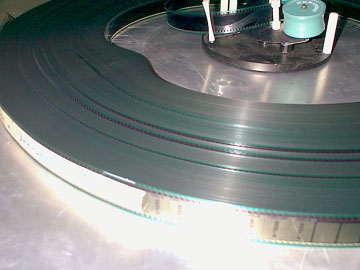|
|
This topic comprises 2 pages: 1 2
|
|
Author
|
Topic: Static Cling
|
Jason A. Forno
Film Handler
Posts: 8
From: Ormond Beach, FL, USA
Registered: Apr 2001
|
 posted 04-24-2001 02:04 AM
posted 04-24-2001 02:04 AM




I have a quick question for anyone who cares to respond. In the last several days my print of Pokemon 3 has been giving me a rather difficult time. I have dealt with this problem in the past, but not with such severity before. I have to clarify one thing, and that is that I am dealing with 15 year old projectors here. I have tried using the sorry-ass PTR's, Film Lube, and even a Indian rain dance... with little results. If anyone knows a trick to help prevent this disorder, please let me know.  Also... I even tried this trick that was shown to me by the man who passed on his projection knowladge to me. Wherever you are Mr.A, it doesn't work. (slip a white cotton glove on, pinch the film as its being feed out from the brain.) This problem is just one more reason to hate that stupid, little, yellow creature. ------------------
| IP: Logged
|
|
|
|
Randy Stankey
Film God

Posts: 6539
From: Erie, Pennsylvania
Registered: Jun 99
|
 posted 04-24-2001 03:17 AM
posted 04-24-2001 03:17 AM




You should also check out the film and make sure it isn't damaged. I say this because you tell us that the problem occurred within the last day or two. This leads me to think something has gone wrong.One thing that can happen is that your print has been "spiked". ("Roping" is the correct term but I think "spiked" is more descriptive.) Let's say that one of your pad rollers has somehow come loose. The film will jump partially off the sprocket and the teeth will put little dents in the film. This will cause the film to run throug the brain (payout control plate) all funky-like. Layers of film will be pulled off as the print unwinds on the payout platter. Is this what's happening to you? Here is an example of what a roped print might look like:

One thing you can do really quick is to press on the print as it winds up on the take-up platter. Is it all spongy? If so, check your film for damage. You may also notice that when you are in the last one or two reels of the movie, the film starts looking like a many-sided polygon. There are other causes for this, like improper humidity levels but "spiking" can cause this too.
If you have verified that all this is true the first thing you need to do is to go over the projector with a fine-tooth comb and find out where the damage is occuring. You should be able to find the roller that's fouled up. Other possible causes for this are bad splices that cause the print to "jump the track" as it runs. A good indicator of this is when part of the print is OK and part of it is not. You'll find the bad splice right near the place where the damage starts. Look for lab splices (Some people call them "Chemical Splices" although that's not entirely correct.) Another thing to look for is one of your splices that didn't get all the holes punched out properly. Maybe there's a "flap" hanging off the film where the blade didn't cut the film off flush. After that, the only thing left is that somebody made a Boo-Boo and didn't thread up properly. YOU HAVE TO CHECK THE PROJECTOR BEFORE YOU START THE MOVIE! Sorry if I sound like I'm dissing on you but I've seen this happen all too often. Somebody starts the projector and walks away, never to return. I know YOU didn't do this but now you have ammunition to get on somebody ELSE'S case.  So... OK... what do we do if you do have damaged film? Pretty much there's nothing you can do.
You can filp the film over and run it with the soundtrack down (Or soundtrack UP) Sometimes that will help but not always. Another thing you can do is break the film down onto 6,000 foot reels. Take it over to the rewind bench and turn the tension on the payout spindle way up. What you hope to accomplish is to flatten the film out a little bit. Sometimes this works and sometimes it doesn't. This is a risky move as well. You can scratch the hell out of the film doing this and you can stretch it out as well. But if the film is already in crappy condition, what have you got to lose? After all this the only option is to either live with it or replace the print. If you elect to live with it you'll have to keep a close eye on this print for as long as you have it. It's liable to wrap on you in a heartbeat. Your only hope is that MAYBE the damage will "Play itself out". (The film will flatten out again after many runs.) This isn't likely unless the damage is very slight. Lastly you COULD try FilmGuard. I don't know if it will help or not. Again, you have little to lose at this point. Really, I hope you don't have damaged film. This would give you a good reason to try out FilmGuard and see how it works. I wish you luck! I hope it's NOT really damaged! 
| IP: Logged
|
|
John Pytlak
Film God

Posts: 9987
From: Rochester, NY 14650-1922
Registered: Jan 2000
|
 posted 04-24-2001 06:54 AM
posted 04-24-2001 06:54 AM





Jason: Randy is correct that "static cling" is not the only cause of sticky prints. Check out my article "All that Sticks is NOT Static" in the September 2000 issue of Kodak Cinema Notes, H-50-56 in the "Manuals" section of Film-Tech.Being that you are in Florida, HIGH HUMIDITY can cause the film to be limp and sticky. Ideally, the humidity in the projection room should be between 50 and 60 percent. Kodak VISION Color Print Film has a transparent conductive anti-static coating on the back side. Most laboratories also use a Kodak-recommended anti-static additive in their print film process. These measures have greatly reduced the incidence and severity of "static cling", but some platters are more prone to build up static on the print. If the problem is due to static, try some of the procedures recommended in my article in the September 1998 issue of Filmnotes for Reel People:
http://www.kodak.com/US/en/motion/newsletters/reel/september98/pppp.shtml
------------------
John P. Pytlak, Senior Technical Specialist
Worldwide Technical Services, Entertainment Imaging
Eastman Kodak Company
Research Labs, Building 69, Room 7419
Rochester, New York, 14650-1922 USA
Tel: 716-477-5325 Cell: 716-781-4036 Fax: 716-722-7243
E-Mail: john.pytlak@kodak.com
Web site: http://www.kodak.com/go/motion
| IP: Logged
|
|
|
|
Jerry Chase
Phenomenal Film Handler

Posts: 1068
From: Margate, FL, USA
Registered: Nov 2000
|
 posted 04-24-2001 10:11 AM
posted 04-24-2001 10:11 AM




"Being that you are in Florida, HIGH HUMIDITY can cause the film to be limp and sticky. Ideally, the humidity in the projection room should be between 50 and 60 percent."So THAT's whats wrong with me!!  Seriously, that shouldn't be a problem now. Florida is in the middle of the dry season, and temperatures are down. Seriously, that shouldn't be a problem now. Florida is in the middle of the dry season, and temperatures are down. Randy gave an excellent description of some of the things that can happen. I'm not sure about "ironing" the film by pressing it on the rewind bench though. That seems a little brutal, and I've seen the scratches that can occur when tightly wound film cinches on the reel, digging any stray dirt into the emulsion. I suppose if you wanted to try to push the spikes back in, you could try running it between some free-rolling metal dowels. Maybe that is an idea for someone to invent, a spike-pusher-inner. It could go right next to the film stretcher.
| IP: Logged
|
|
John Pytlak
Film God

Posts: 9987
From: Rochester, NY 14650-1922
Registered: Jan 2000
|
 posted 04-24-2001 11:28 AM
posted 04-24-2001 11:28 AM





Jerry: Certainly you must agree that Florida can have high humidity. And any coastal area (e.g., Ormond Beach, just north of Daytona) can be pretty "sticky" at times, depending on the wind direction. Measurement with an accurate digital humidity gauge is always a good idea to rule out sticky dampness or bone dry static conditions as factors.------------------
John P. Pytlak, Senior Technical Specialist
Worldwide Technical Services, Entertainment Imaging
Eastman Kodak Company
Research Labs, Building 69, Room 7419
Rochester, New York, 14650-1922 USA
Tel: 716-477-5325 Cell: 716-781-4036 Fax: 716-722-7243
E-Mail: john.pytlak@kodak.com
Web site: http://www.kodak.com/go/motion
| IP: Logged
|
|
|
|
|
|
|
|
Jerry Chase
Phenomenal Film Handler

Posts: 1068
From: Margate, FL, USA
Registered: Nov 2000
|
 posted 04-24-2001 03:31 PM
posted 04-24-2001 03:31 PM




chartFor Evans "I agree that a sling psychometer is fun to use. But I may need new reading glasses to see the fine print on the psychometric chart!" Careful of the spelling on that. Psychrometrics, psychometrics, and pyschometry are all different things.
| IP: Logged
|
|
|
|
|
|
|
|
|
|
|
|
All times are Central (GMT -6:00)
|
This topic comprises 2 pages: 1 2
|
Powered by Infopop Corporation
UBB.classicTM
6.3.1.2
The Film-Tech Forums are designed for various members related to the cinema industry to express their opinions, viewpoints and testimonials on various products, services and events based upon speculation, personal knowledge and factual information through use, therefore all views represented here allow no liability upon the publishers of this web site and the owners of said views assume no liability for any ill will resulting from these postings. The posts made here are for educational as well as entertainment purposes and as such anyone viewing this portion of the website must accept these views as statements of the author of that opinion
and agrees to release the authors from any and all liability.
|

 Home
Home
 Products
Products
 Store
Store
 Forum
Forum
 Warehouse
Warehouse
 Contact Us
Contact Us




 Printer-friendly view of this topic
Printer-friendly view of this topic














 digital hygrometer from Radio Shack for less than 30 dollars:
digital hygrometer from Radio Shack for less than 30 dollars: Don't think a spell-check would have caught that one! Even looks like the University of Illinois at Urbana (follow my link) had it wrong. I'll write on the blackboard 100 times: PSYCHROMETER and PSYCHROMETRIC
Don't think a spell-check would have caught that one! Even looks like the University of Illinois at Urbana (follow my link) had it wrong. I'll write on the blackboard 100 times: PSYCHROMETER and PSYCHROMETRIC



